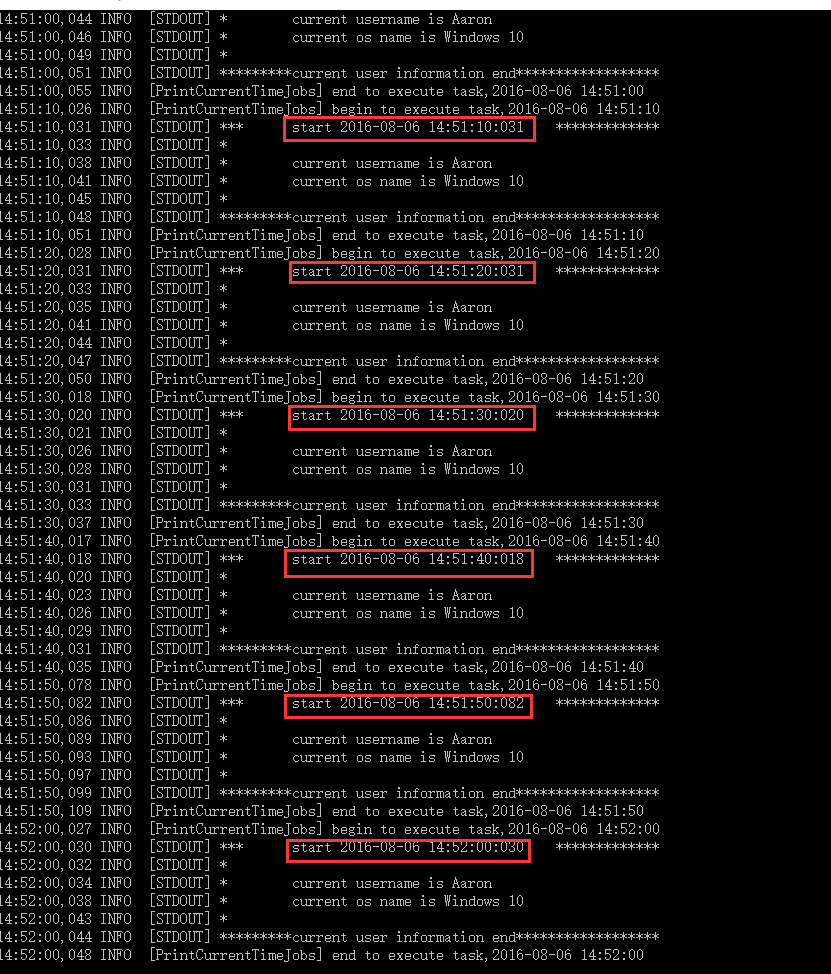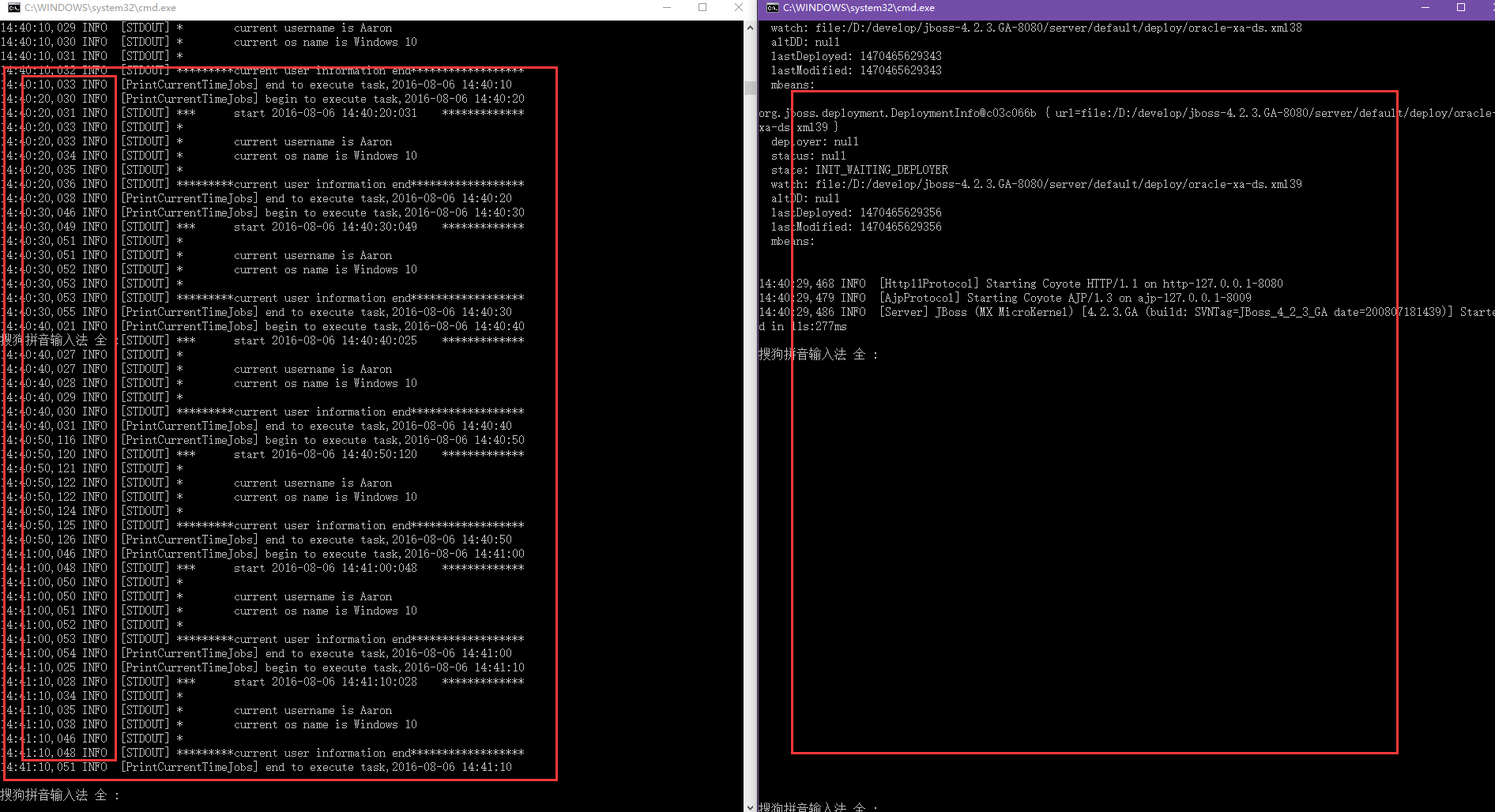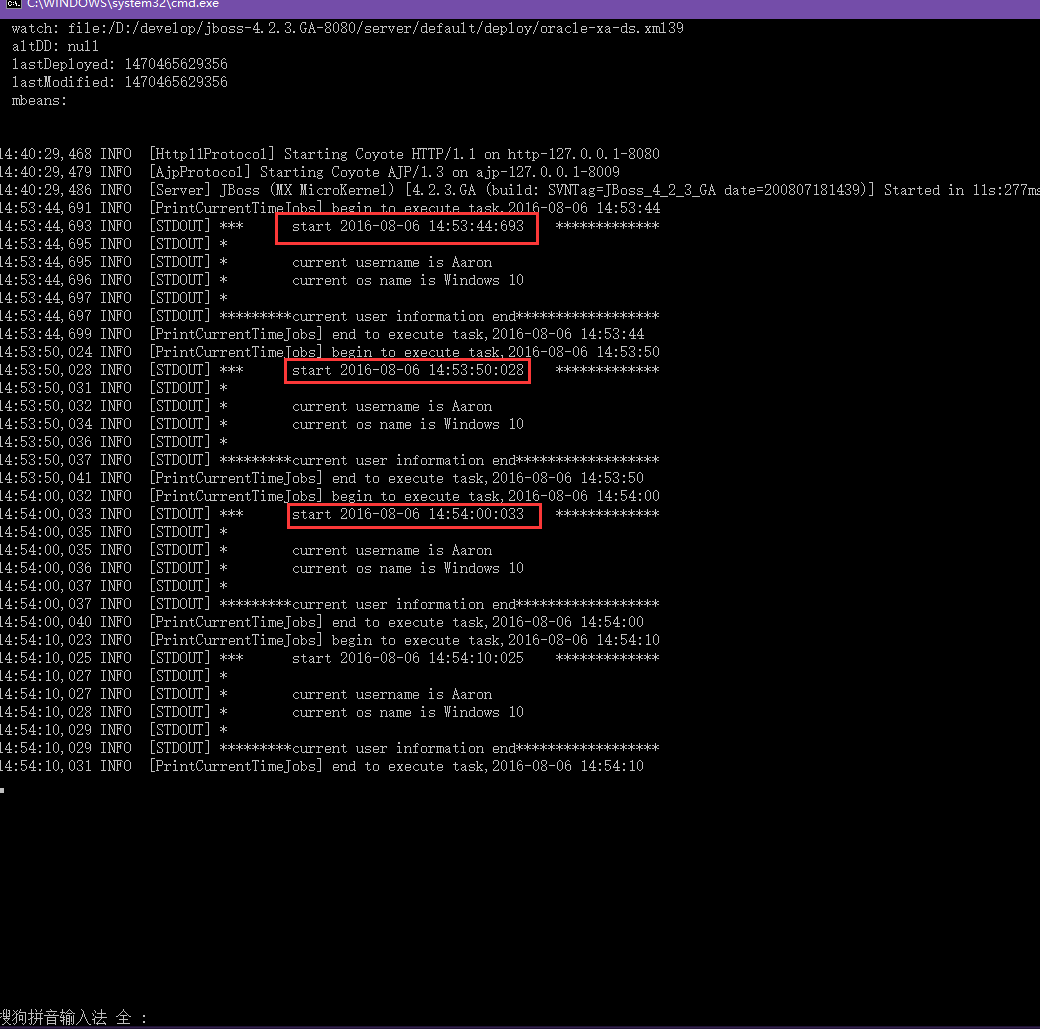更新時(shí)間:2021-08-17 09:29:37 來源:動(dòng)力節(jié)點(diǎn) 瀏覽898次
目前在集群中處理定時(shí)任務(wù)的方式不是正真的分布式處理方式,而是一種偽分布式,這種方式存在一個(gè)明顯的缺陷就是當(dāng)集群中機(jī)器宕機(jī),那么整個(gè)定時(shí)任務(wù)就會(huì)掛掉或者不能一次性跑完,會(huì)對(duì)業(yè)務(wù)產(chǎn)生嚴(yán)重的影響
利用spring+quartz構(gòu)建一套真正的分布式定時(shí)任務(wù)系統(tǒng),經(jīng)過查閱相關(guān)資料得知:quartz框架是原生就支持分布式定時(shí)任務(wù)的
開發(fā)IDE:Intellij IDEA
JDK版本:1.8
Spring版本:4.2.6
Quartz版本:2.2.1
Spring與Quartz集成配置
<?xml version="1.0" encoding="UTF-8"?>
<beans xmlns="http://www.springframework.org/schema/beans"
xmlns:xsi="http://www.w3.org/2001/XMLSchema-instance" xmlns:context="http://www.springframework.org/schema/context"
xsi:schemaLocation="http://www.springframework.org/schema/beans
http://www.springframework.org/schema/beans/spring-beans-4.0.xsd http://www.springframework.org/schema/context http://www.springframework.org/schema/context/spring-context.xsd">
<context:component-scan base-package="com.aaron.clusterquartz.job"/>
<bean name="dataSource" class="org.springframework.jndi.JndiObjectFactoryBean">
<!-- tomcat -->
<!--<property name="jndiName" value="java:comp/env/jndi/mysql/quartz"/>-->
<!-- jboss -->
<property name="jndiName" value="jdbc/quartz"/>
</bean>
<!-- 分布式事務(wù)配置 start -->
<!-- 配置線程池-->
<bean name="executor" class="org.springframework.scheduling.concurrent.ThreadPoolTaskExecutor">
<property name="corePoolSize" value="15"/>
<property name="maxPoolSize" value="25"/>
<property name="queueCapacity" value="100"/>
</bean>
<bean name="transactionManager" class="org.springframework.jdbc.datasource.DataSourceTransactionManager">
<property name="dataSource" ref="dataSource"/>
</bean>
<!-- 配置調(diào)度任務(wù)-->
<bean name="quartzScheduler" class="org.springframework.scheduling.quartz.SchedulerFactoryBean">
<property name="configLocation" value="classpath:quartz.properties"/>
<property name="dataSource" ref="dataSource"/>
<property name="transactionManager" ref="transactionManager"/>
<!-- 任務(wù)唯一的名稱,將會(huì)持久化到數(shù)據(jù)庫-->
<property name="schedulerName" value="baseScheduler"/>
<!-- 每臺(tái)集群機(jī)器部署應(yīng)用的時(shí)候會(huì)更新觸發(fā)器-->
<property name="overwriteExistingJobs" value="true"/>
<property name="applicationContextSchedulerContextKey" value="appli"/>
<property name="jobFactory">
<bean class="com.aaron.clusterquartz.autowired.AutowiringSpringBeanJobFactory"/>
</property>
<property name="triggers">
<list>
<ref bean="printCurrentTimeScheduler"/>
</list>
</property>
<property name="jobDetails">
<list>
<ref bean="printCurrentTimeJobs"/>
</list>
</property>
<property name="taskExecutor" ref="executor"/>
</bean>
<!-- 配置Job詳情 -->
<bean name="printCurrentTimeJobs" class="org.springframework.scheduling.quartz.JobDetailFactoryBean">
<property name="jobClass" value="com.aaron.clusterquartz.job.PrintCurrentTimeJobs"/> <!--因?yàn)槲沂褂昧藄pring的注解,所以這里可以不用配置scheduler的屬性-->
<!--<property name="jobDataAsMap">
<map>
<entry key="clusterQuartz" value="com.aaron.framework.clusterquartz.job.ClusterQuartz"/>
</map>
</property>-->
<property name="durability" value="true"/>
<property name="requestsRecovery" value="false"/>
</bean>
<!-- 配置觸發(fā)時(shí)間 -->
<bean name="printCurrentTimeScheduler" class="com.aaron.clusterquartz.cron.PersistableCronTriggerFactoryBean">
<property name="jobDetail" ref="printCurrentTimeJobs"/>
<property name="cronExpression">
<value>0/10 * * * * ?</value>
</property>
<property name="timeZone">
<value>GMT+8:00</value>
</property>
</bean>
<!-- 分布式事務(wù)配置 end -->
</beans>
quartz屬性文件
#============================================================================
# Configure JobStore
# Using Spring datasource in quartzJobsConfig.xml
# Spring uses LocalDataSourceJobStore extension of JobStoreCMT
#============================================================================
org.quartz.jobStore.useProperties=true
org.quartz.jobStore.tablePrefix = QRTZ_
org.quartz.jobStore.isClustered = true
org.quartz.jobStore.clusterCheckinInterval = 5000
org.quartz.jobStore.misfireThreshold = 60000
org.quartz.jobStore.txIsolationLevelReadCommitted = true
# Change this to match your DB vendor
org.quartz.jobStore.class = org.quartz.impl.jdbcjobstore.JobStoreTX
org.quartz.jobStore.driverDelegateClass = org.quartz.impl.jdbcjobstore.StdJDBCDelegate
#============================================================================
# Configure Main Scheduler Properties
# Needed to manage cluster instances
#============================================================================
org.quartz.scheduler.instanceId=AUTO
org.quartz.scheduler.instanceName=MY_CLUSTERED_JOB_SCHEDULER
org.quartz.scheduler.rmi.export = false
org.quartz.scheduler.rmi.proxy = false
#============================================================================
# Configure ThreadPool
#============================================================================
org.quartz.threadPool.class = org.quartz.simpl.SimpleThreadPool
org.quartz.threadPool.threadCount = 10
org.quartz.threadPool.threadPriority = 5
org.quartz.threadPool.threadsInheritContextClassLoaderOfInitializingThread = true
相關(guān)類說明
AutowiringSpringBeanJobFactory類是為了可以在scheduler中使用spring注解,如果不使用注解,可以不適用該類,而直接使用
SpringBeanJobFactory
package com.aaron.clusterquartz.autowired;
import org.quartz.spi.TriggerFiredBundle;
import org.springframework.beans.BeansException;
import org.springframework.beans.factory.config.AutowireCapableBeanFactory;
import org.springframework.context.ApplicationContext;
import org.springframework.context.ApplicationContextAware;
import org.springframework.scheduling.quartz.SpringBeanJobFactory;
/**
* @author
* @description 使job類支持spring的自動(dòng)注入
* @date 2016-05-27
*/
public class AutowiringSpringBeanJobFactory extends SpringBeanJobFactory implements ApplicationContextAware{
private transient AutowireCapableBeanFactory beanFactory;
public void setApplicationContext(ApplicationContext applicationContext) throws BeansException
{
beanFactory = applicationContext.getAutowireCapableBeanFactory();
}
@Override
protected Object createJobInstance(TriggerFiredBundle bundle) throws Exception
{
Object job = super.createJobInstance(bundle);
beanFactory.autowireBean(job);
return job;
}
}
package com.aaron.clusterquartz.job;
import com.arron.util.DateUtils;
import org.apache.commons.logging.Log;
import org.apache.commons.logging.LogFactory;
import org.quartz.JobExecutionContext;
import org.quartz.JobExecutionException;
import org.springframework.beans.factory.annotation.Autowired;
import org.springframework.scheduling.quartz.QuartzJobBean;
import java.util.Date;
/**
* @author
* @description 一句話描述該文件的用途
* @date 2016-05-23
*/
public class PrintCurrentTimeJobs extends QuartzJobBean
{
private static final Log LOG_RECORD = LogFactory.getLog(PrintCurrentTimeJobs.class);
//這里就是因?yàn)橛猩衔闹械腁utowiringSpringBeanJobFactory才可以使用@Autowired注解,否則只能在配置文件中設(shè)置這屬性的值
@Autowired
private ClusterQuartz clusterQuartz;
protected void executeInternal(JobExecutionContext jobExecutionContext) throws JobExecutionException
{
LOG_RECORD.info("begin to execute task," + DateUtils.dateToString(new Date()));
clusterQuartz.printUserInfo();
LOG_RECORD.info("end to execute task," + DateUtils.dateToString(new Date()));
}
}
測(cè)試結(jié)果:
由于只有一臺(tái)電腦,所有開了8080和8888兩個(gè)端口來測(cè)試的,上面的定時(shí)任務(wù)設(shè)置了每10秒運(yùn)行一次。
當(dāng)只啟動(dòng)8080端口時(shí),可以看到控制臺(tái)每隔10秒打印一條語句

兩個(gè)端口同時(shí)啟動(dòng)的對(duì)比測(cè)試中可以看到,只有一個(gè)端口在跑定時(shí)任務(wù)

這個(gè)關(guān)了正在跑定時(shí)任務(wù)的端口后,之前的另一個(gè)沒有跑的端口開始接管,繼續(xù)運(yùn)行定時(shí)任務(wù)

至此,我們可以清楚地看到,在分布式定時(shí)任務(wù)中(或者集群),同一時(shí)刻只會(huì)有一個(gè)定時(shí)任務(wù)運(yùn)行。
以上就是動(dòng)力節(jié)點(diǎn)小編介紹的"基于spring+quartz的分布式定時(shí)任務(wù)框架",希望對(duì)大家有幫助,想了解更多可查看Java分布式應(yīng)用教程。動(dòng)力節(jié)點(diǎn)在線學(xué)習(xí)教程,針對(duì)沒有任何Java基礎(chǔ)的讀者學(xué)習(xí),讓你從入門到精通,主要介紹了一些Java基礎(chǔ)的核心知識(shí),讓同學(xué)們更好更方便的學(xué)習(xí)和了解Java編程,感興趣的同學(xué)可以關(guān)注一下。
 Java實(shí)驗(yàn)班
Java實(shí)驗(yàn)班
0基礎(chǔ) 0學(xué)費(fèi) 15天面授
 Java就業(yè)班
Java就業(yè)班
有基礎(chǔ) 直達(dá)就業(yè)
 Java夜校直播班
Java夜校直播班
業(yè)余時(shí)間 高薪轉(zhuǎn)行
 Java在職加薪班
Java在職加薪班
工作1~3年,加薪神器
 Java架構(gòu)師班
Java架構(gòu)師班
工作3~5年,晉升架構(gòu)
提交申請(qǐng)后,顧問老師會(huì)電話與您溝通安排學(xué)習(xí)